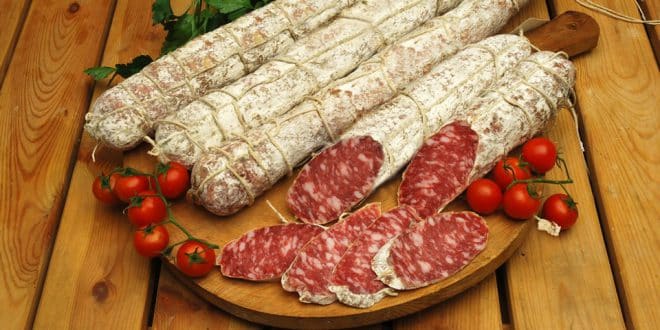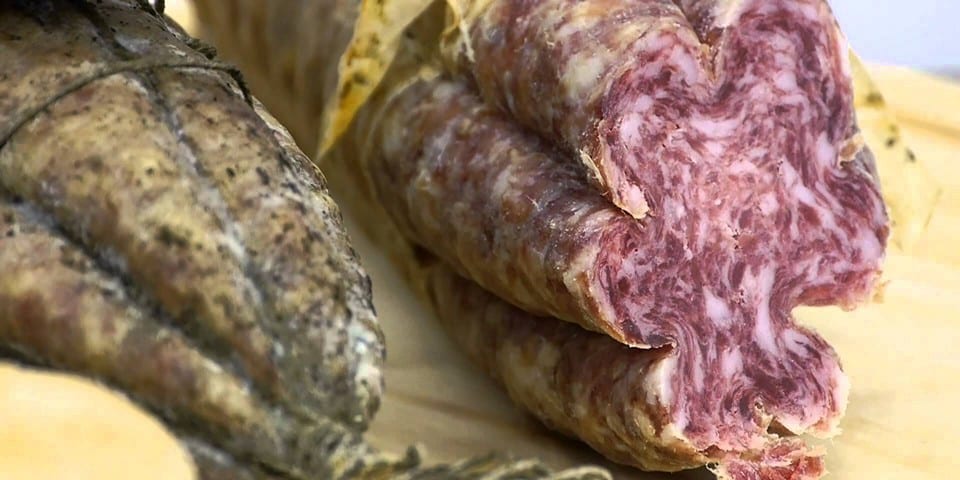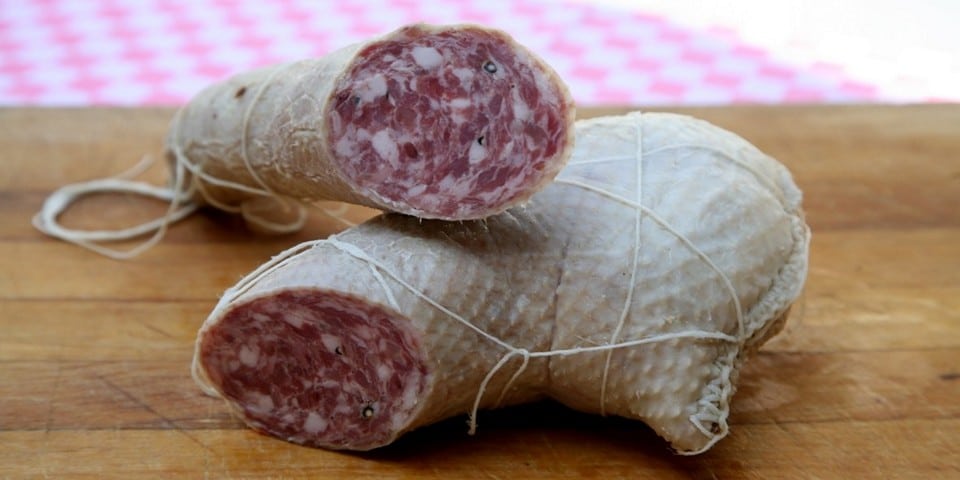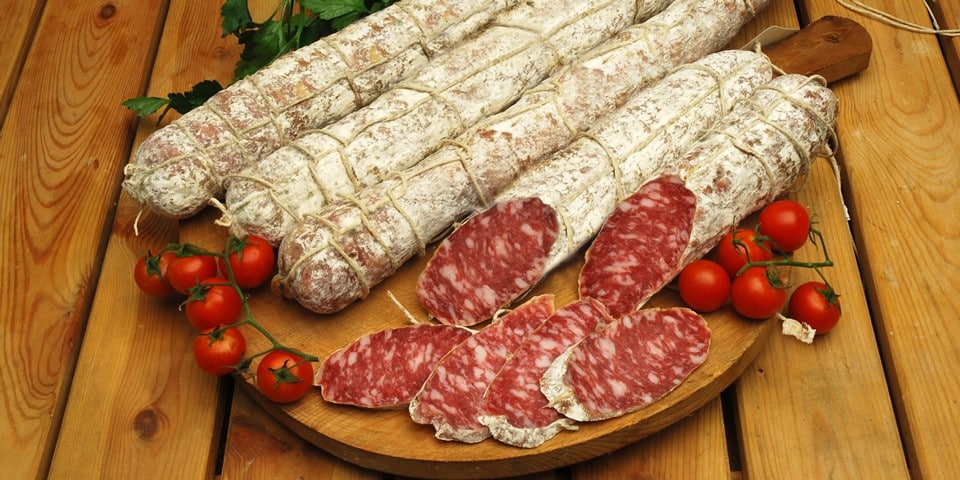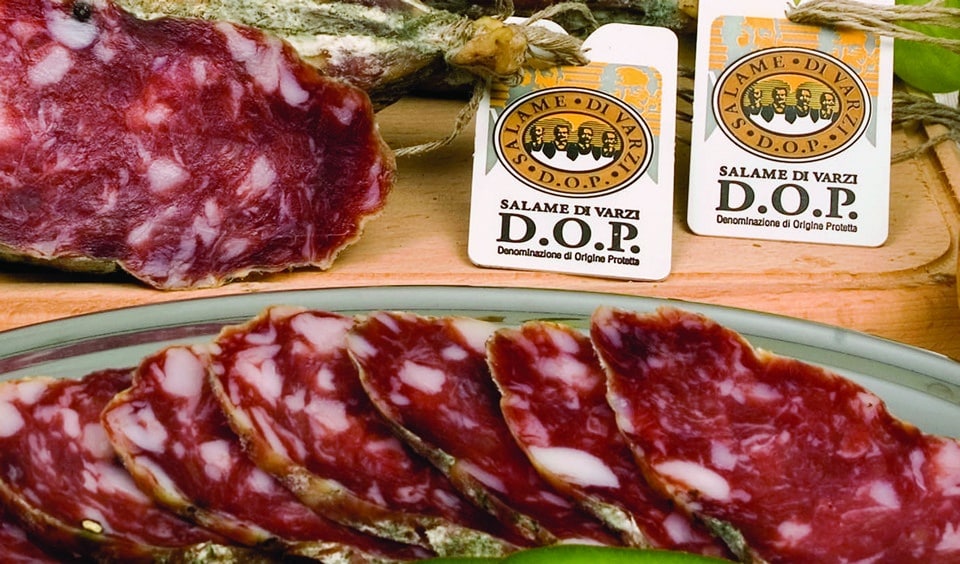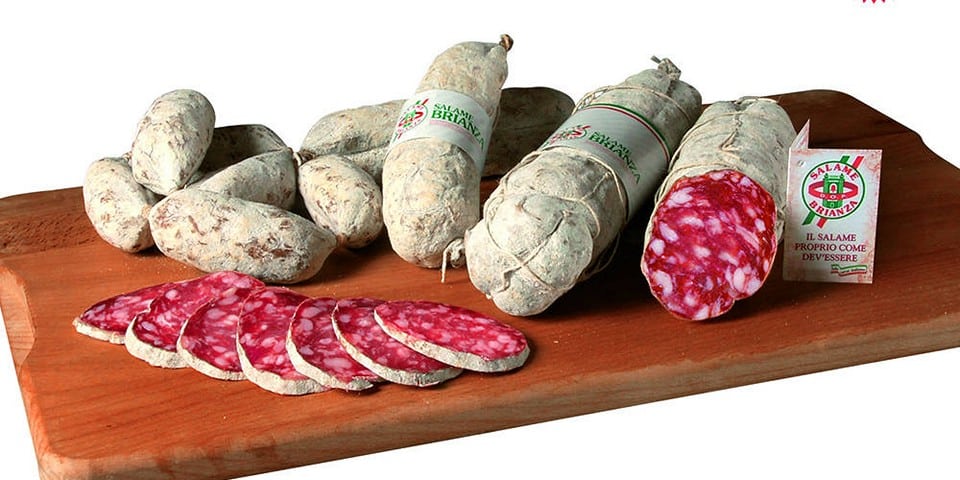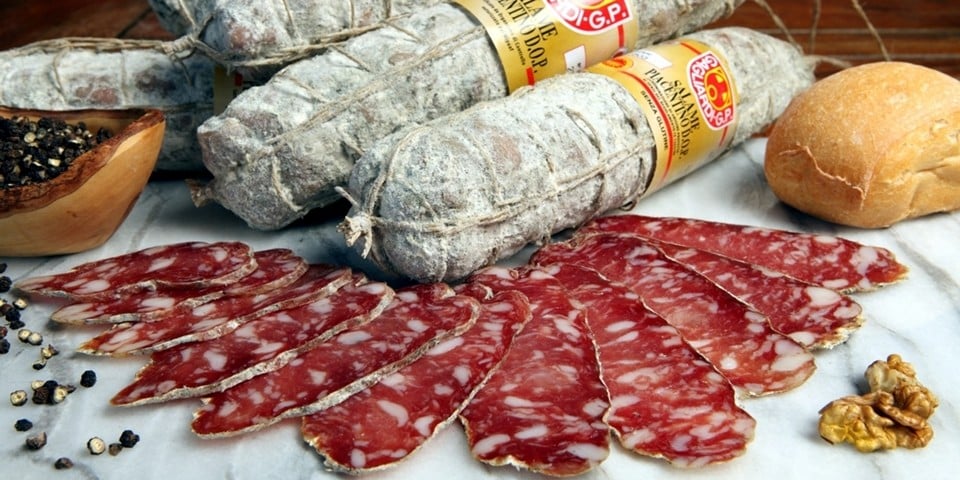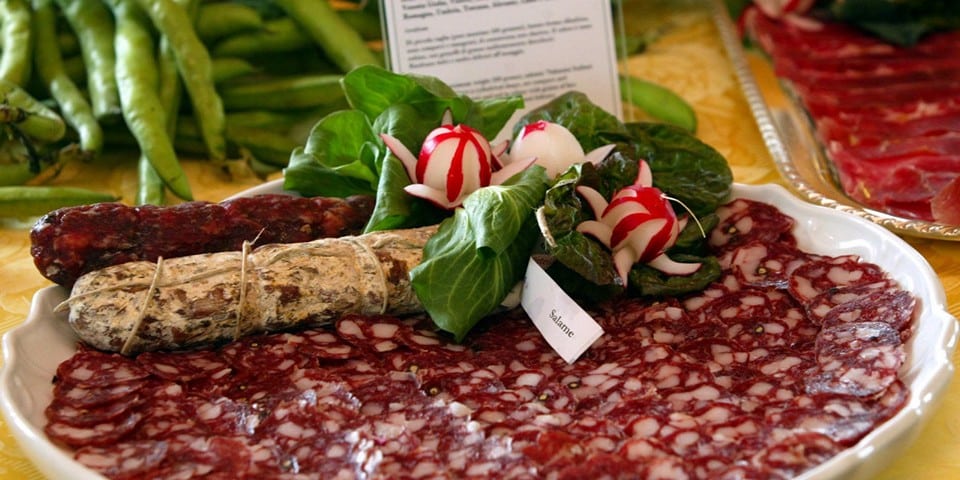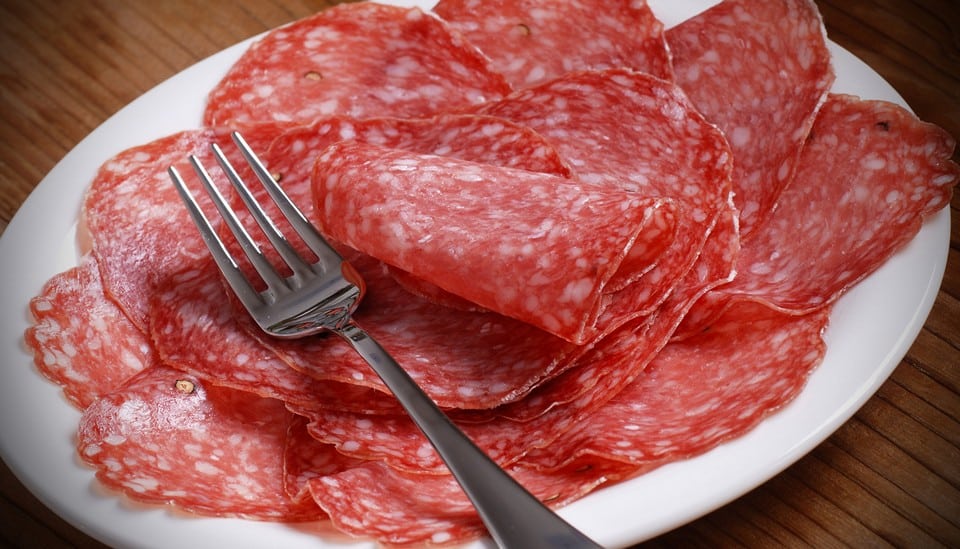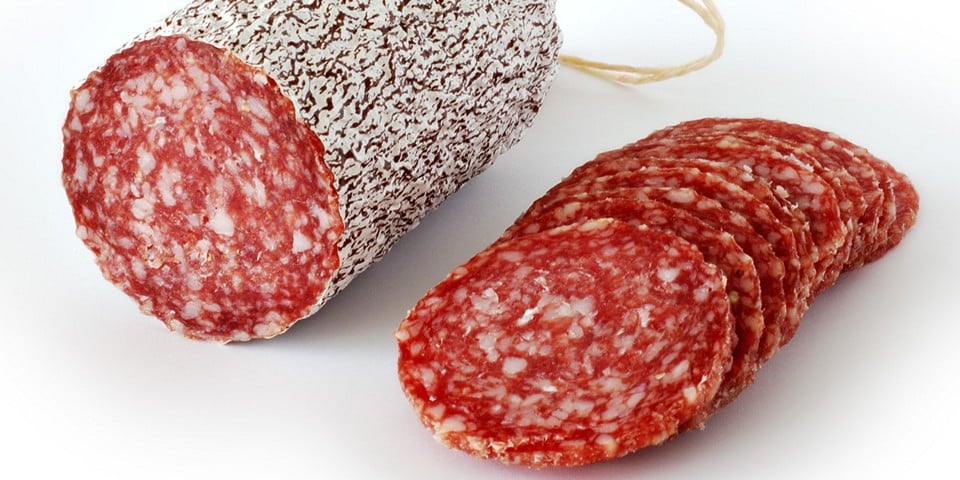This time, we will once again talk about an Italian product that has firmly established itself on American tables. Salami – a variety of hard sausage with fat, highly appreciated worldwide. In the past, it was enjoyed only by privileged classes in Italy.
Today, almost anyone can afford Salami, at least for special occasions. “Two slices of sausage were lying on your table!” – as sung in a popular 90s song. But we won’t tell you stories like the hero of the hit, instead, we will present the most truthful tale about Salami.
Page Contents
IGP and DOP Categories of Salami
Many people love Salami, which is why it is produced in most civilized countries worldwide. However, as it is known, not all sausages are created equal, and to truly appreciate the original taste, one must visit its birthplace – Italy. In the republic, there are also a large number of producers. However, only some products are honored with special designations – IGP or DOP categories. These abbreviations in the name indicate the commitment to traditional production methods and the high quality of Italian Salami.
Salama da sugo IGP
Salama da Sugo is a sausage that is typical of the province of Ferrara but looks quite extraordinary. It is made from pork meat, tongue, liver, wine, salt, and spices (nutmeg, cloves, cinnamon, pepper). It has a melon-like shape and is tied with string. It may be covered with a natural white mold that forms during the ripening process. The weight of the sausages ranges from 0.7 to 1.4 kg (1.5 to 3.1 lbs). It has a dark brown color, an intense aroma, and a soft, grainy texture. The minimum aging period is 6 months.
The special feature of Salama da Sugo is that it is usually further prepared before consumption. It is soaked in cold water to soften the mold, gently scrubbed, and then boiled for at least 4 hours. It is crucial to ensure that the sausage casing is not damaged. The finished product is enjoyed warm with mashed potatoes or pumpkin, sliced into individual pieces.
Salame Cremona IGP
Cremona Salami is made from pork raised in the production areas of Prosciutto di Parma and Prosciutto di San Daniele. It is a mixture of fresh pork, salt, and crushed garlic stuffed into the casings of pigs, cattle, sheep, or horses.
The maturation period ranges from 5 weeks to over 4 months. The Salami has a cylindrical shape with a diameter of 2.6 inches (65 mm) and a length of 5.9 inches (150 mm). The weight of the finished product is 1.1 pounds (500 grams). The Salami cuts smoothly even after extended aging. It has an intense red color, a rich aroma, and a spicy taste. Cremona Salami pairs well with vegetables, fruits, bread, and cheeses.
Enjoy Also: Prosciutto – The Ultimate Guide to Italian Hams.
Salame d’Oca di Mortara IGP
Salame d’Oca di Mortara IGP is produced in the province of Pavia. It is made from a combination of pork and goose meat. During the last 3 months of their life, geese must exclusively feed on green fodder and grains and weigh at least 8.8 pounds (4 kg) before slaughter. The Salami is encased in goose skin. It has a homogeneous texture and does not crumble. The sliced surface has a dark red color with streaks of fat. It has a spicy aroma and a delicate and mild flavor. The size of the Salami ranges from 0.7 to 8.8 pounds (0.3 to 4 kg). Salame d’Oca di Mortara pairs excellently with fresh and braised vegetables.
Salame Sant’Angelo IGP
Salame Sant’Angelo IGP is a Salami made from pork raised in the Nebrodi region. It has an elongated cylindrical shape and a natural white mold coating. The texture is tender and compact. The meat has a ruby red color, while the fat is white. It has a delicate aroma and a spicy and aromatic taste, thanks to the special microclimate of the valley. The maturation time ranges from 30 to 90 days. The size of the fat inclusions is larger compared to other varieties. Salame Sant’Angelo is enjoyed as an appetizer or as an accompaniment to spirits.
Salame Felino IGP
Salame Felino is a product from the town of Felino in the province of Parma. In addition to meat and spices, it contains dry white wine, which sets it apart from other varieties. The weight of the salame stick varies from 0.2 to 4.5 kg, and it has a cylindrical shape. The texture is compact and not elastic. The color is ruby red, with a delicate aroma and a sweet taste. The minimum aging time is 25 days. The size of the slices is essential for consumption. Traditionally, Salame Felino is sliced thickly (7 mm) and diagonally. It is served with bread and Parma ham.
Salame Piemonte IGP
The production area of Salame Piemonte is limited to the territory of the eponymous region. In addition to spices, the Salame is flavored with red wines from Piemonte made from Nebbiolo, Barbera, and Dolcetto grapes. The Salame stick has a cylindrical shape and weighs at least 300 g. The slice is ruby red, with a compact and uniform texture, and contains specks of fat and pepper grains. The taste is sweet and delicate due to a short aging period (10-50 days depending on weight). Salame Piemonte stands out for its aroma of aged wine and garlic. It is sliced just before serving and enjoyed with fresh bread, mustard, cheeses, and salads. It is also served with various porridges and mashed potatoes.
Salame di Varzi DOP
Salame di Varzi comes from the municipality of Varzi in the province of Pavia. The Salame is a mixture of fresh meat and large-cut fat. The fat content constitutes approximately 30-33% of the product’s total weight. It has a cylindrical shape, with a bright red color and white specks of fat in the slice. The consistency is firm, and the texture is compact. The aging time depends on the weight and variety: Varzi-Filzetta (0.5-0.7 kg, aged for 45 days), Varzi-Filzettone (0.5-1 kg, aged for 60 days), Varzi-Sottocrespone (1-2 kg, aged for 120 days), Varzi-Cucito (1-2 kg, aged for 180 days). The taste is sweet and delicate. Salame di Varzi is sliced into thick slices and complements vegetable salads with vegetable oil, cheeses, and wines.
Salame Brianza DOP
Salame Brianza is made from the meat of pigs raised in the regions of Emilia-Romagna, Lombardy, and Piedmont. In addition to salt, pepper, garlic, and wine, sugar is also allowed as an ingredient. It has a cylindrical shape with a diameter of 65 mm (2.6 inches) and a length of 150 mm (5.9 inches). The weight of the finished product varies from 0.2 to 4.5 kg (0.44 to 9.9 lbs). It has a compact texture that is not elastic. The color is intense ruby red, with a rich aroma and a spicy taste. The minimum aging time is 25 days. When serving Salame Brianza, the thickness of the slices is important. Traditionally, it is cut into thick slices (7 mm or 0.28 inches) diagonally. It is often enjoyed with bread and Prosciutto di Parma.
Salame Piacentino DOP
Salame Piacentino is made from pigs’ meat and fat in the Piacenza province. It contains a fat content ranging from 10% to 30%. The finished product has a cylindrical shape and weighs between 400 g (14.1 oz) and 1 kg (2.2 lbs). It has a compact texture. The color of the slice is bright red with distinct fat inclusions. A delicate meat scent with a hint of spices characterizes the aroma. The taste is tender, with a subtle sweetness that becomes more intense with age. The aging period depends on the weight and is at least 45 days. Salame Piacentino is enjoyed as an appetizer and used in various recipes.
Salamini Italiani alla Cacciatora DOP
Salamini Italiani alla Cacciatora, also known as “Cacciatora Salami,” is produced in 11 regions of Italy.
Its name translates to “hunter,” which is associated with the tradition of hunters carrying Salami as a snack during their hunting trips.
This Salami stands out from other varieties with its rich history. It has a cylindrical shape, measuring approximately 20 cm (7.9 inches) in length and 6 cm (2.4 inches) in diameter. It has an average weight of 350 g (12.3 oz). The texture is dense and not elastic. The slice has a ruby-red color with evenly distributed fat grains. It has a subtle aroma and a sweet and delicate taste without any sourness. The minimum aging period is 10 days. Cacciatora Salami is enjoyed with unsalted bread and pairs well with sparkling wine, cheeses, fruits, and vegetables. It is also a great addition to salads.
Salame di Milano
Salame di Milano is not classified under the DOP or IGP categories. However, it is one of the most well-known varieties of Italian Salami. It is made from a blend of finely ground pork and beef, seasoned with salt and a small amount of spices, and stuffed into a natural or synthetic casing. The aging period is approximately 3 months. The slice has a bright red color, almost ruby-like. It has a delicate flavor. Salame di Milano is typically served as part of a charcuterie board or meat platter. Milanese people enjoy it with the traditional michetta bread.
Salami Origin
The history of Salami in modern-day Italy dates back to the period of the Roman Empire. The name of the product comes from the Latin word “salumen,” but it only appeared in the Middle Ages and meant that the product was preserved with salt. This term was used not only for meat but also for fish. However, over time, the term “salami” became increasingly associated with pork.
Although the first attempts to preserve meat with salt can be attributed to the history of prosciutto, it was in rural areas that the method of packing minced meat into animal intestines quickly gained dominance.
Mass production of Salami began in the Middle Ages when the first large pig farms appeared in close proximity to dairy processing facilities. The by-products of cheese and cottage cheese production were ideal for pig feed. The birth of such an industry and Italy’s unique microclimate created perfect conditions for the spread of the art of meat preservation. In Milan, chopped pork was mixed with wine and spices. This type of Salami was served at the festive tables of nobles and feudal lords.
In the 12th century, the Malaspina family’s court served a “new” Salami, aged in wine cellars and “flavored” with smoke. And in 1581, the word “salame” was first mentioned in a cookbook, referring to pork sausage. Prior to that, sausage products were referred to as “insicia.” Later, Salami also made its way to the tables of rural residents when pig farming became an indispensable resource for survival.
The art of making Salami developed differently depending on the region of Italy, which inevitably led to a variety of Italian Salami varieties, even within the same region.
Production
The quality of Italian Salami is maintained not only in the production facility but also in the regulated territory and feed for raising the pigs whose meat is used in sausage making. The animals are slaughtered at a weight of 160-180 kg. Their diet consists mainly of grains and by-products of milk processing. As a result of this diet, the raw material is rich in saturated fatty acids and has a low level of cholesterol.
Salami may contain not only pork but also meat from sheep, goats, horses, geese, donkeys, boars, and their by-products. However, the fatty part is taken only from pigs due to its organoleptic properties.
Before starting the preparation, the meat is trimmed to remove tendons and fat. It is carefully cleaned and chilled to a temperature of 7 degrees Celsius. The parts of the carcass used for making Salami and the fineness of the grind depend on the type of sausage.
Salt and spices are added to the mixture, the presence of which is determined by the type of product. Common spices include garlic, black and white pepper (ground or whole), dill, nutmeg, cloves, and others. Unusual Salami variations can be found in some regions of Italy, such as those with walnuts or pistachios. An unconventional method can also be the addition of milk or wine to the raw material. The use of sodium nitrite as a coloring and mild preservative is permitted by law.
The sausage mixture is then stuffed into natural (pig, sheep, cattle, and horse intestines) or synthetic (cellulose) casings. For preliminary drying, the Salami is placed in warm rooms for 3-7 days. Further, aging takes place at a temperature of 10-15 degrees Celsius. The aging period varies depending on the type of Salami. The final stage of preparation for certain types of Salami may involve light smoking to impart a specific aroma.
Calorie Content and Benefits of Salami
The calorie content of Salami, like other products, depends on its type. Let’s consider Salami Milano – the most famous and widely purchased Italian sausage in the world. The calorie content per 100 grams (3.5 ounces) is 384 kcal, consisting of:
- Protein: 25.4 grams (101.4 kcal)
- Fat: 31 grams (278.4 kcal)
- Carbohydrates: 1.1 grams (4.2 kcal)
Salami Milano is a high-energy product. However, the fat in it is easily absorbed due to the development of beneficial microflora during the maturation of the sausage.
Pork meat is rich in protein, which is necessary as a building component for the human body. Moreover, the fermentation of proteins during the maturation process improves their absorption.
In addition, sausage products are an essential source of bioavailable iron, zinc, and other minerals. Salami is also rich in vitamins B1 and B3, which participate in metabolism and ensure the normal functioning of the nervous and cardiovascular systems, as well as the digestive organs.
Salami is recommended for people with low body weight and loss of appetite, during periods of mental and physiological stress, and during recovery. If you do not belong to any of these categories but still enjoy Salami, it’s essential to be aware that the calorie content of 100 grams can be expended by:
- Cleaning the house for 2.5 hours
- Walking briskly for 1 hour
- Running at a moderate pace for 27 minutes
- Playing football for 34 minutes
- Swimming for 40 minutes
One drawback of the product is its high sodium chloride (salt) content. Excessive consumption of salt can contribute to the development of arterial hypertension.
Recipe at Home
Often, home cooking enthusiasts are drawn to the most exotic and irresistible options. One such option is Salami. If you search for its recipe at home on Italian websites, you will most likely find a method for making sweet dessert sausages.
We will share with you a simple recipe for homemade Salami. However, it is important to note that it is impossible to recreate authentic Italian Salami in your own kitchen. So, here’s what you’ll need:
- Pork – 850 g (1.87 lbs);
- Fatback – 150 g (0.33 lbs);
- Salt – 25 g (0.88 oz);
- Dry wine – 10 ml (0.34 fl oz);
- Pepper – 5 g (0.18 oz);
- Garlic – 5 cloves;
- Spices to taste;
- Pork casings.
You can use a variety of spices in the recipe (cloves, nutmeg, ginger, etc.). It all depends on your taste preferences. Casings are usually sold clean, but it’s still advisable to rinse them under running water. Why do we use pork casings? They have an optimal diameter.
Finely chop the fatback (slices about 10 mm thick) and dice the meat into small cubes. Place the pork in the freezer until it partially freezes (but not completely frozen). Grind the meat using a meat grinder with a large diameter plate, and finely chop the fatback by hand.
Add salt, wine, and spices to the mixture, and mix thoroughly. Using a sausage stuffer attachment, fill the casings with the meat mixture. Make long links by tying off sections of the casing. Carefully inspect the sausages for air bubbles. If any are present, pierce them with a needle.
Tie the sausages with string and hang them in a cool, low humidity place for approximately 7 days. During this time, the sausages will lose some moisture and acquire the desired texture.
The prepared “salami-style” sausages should be stored in the refrigerator. They make an excellent accompaniment to alcoholic beverages. You can also use them to make a delicious homemade pizza by adding cheese, tomatoes, olives, bell peppers, onions, and slices of your homemade masterpiece.
Price of Salami
Conquering Italy and indulging in Salami is quite an intriguing option for a vacation. Especially since you can easily find it without much effort, the famous Salami Milano can be purchased in its homeland at a price ranging from 12 to 25 euros per 1 kg (2.2 lbs).
The not-so-sad story about Salami has come to an end. Enjoying a slice of sausage with crispy bread and then taking a run around the Colosseum seems like the perfect way to start the day. Live brightly, love secretly, travel deliciously, and remember: “You don’t bring your own Salami to Italy!”
Interesting Facts about Salami
- Italian Salami has a rich history dating back to ancient Rome, where it was first mentioned by the poet Virgil in the 1st century BC.
- The name “salami” is derived from the Latin word “salumen,” meaning salted meat. It refers to the curing process used to make Salami, which involves adding salt and various spices to preserve the meat.
- Italy is renowned for its regional Salami varieties, each with its unique flavor profile. Some famous types include Genoa Salami, Milano Salami, and Calabrese Salami.
- Traditional Italian Salami is made from high-quality pork, often sourced from specific breeds and regions known for their superior meat quality, such as Parma or San Daniele.
- The flavor of Italian Salami is enhanced by the addition of various spices and seasonings, such as garlic, black pepper, fennel seeds, and red wine. These ingredients contribute to the distinct taste and aroma of different Salami varieties.
- The curing process of Italian Salami can take several weeks or even months, allowing the flavors to develop and intensify over time. The meat is carefully seasoned, stuffed into casings, and then left to air-dry and mature.
- Italian Salami is incredibly versatile and can be enjoyed in various ways. It is commonly sliced thin and served on charcuterie boards, sandwiches, or as a topping for pizzas and pasta dishes. Its robust flavor adds depth to many Italian recipes.
 Italy for me From Italy with love
Italy for me From Italy with love

